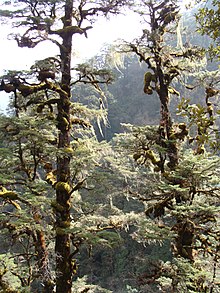Himalayan hemlock
| Himalayan hemlock | ||||||||||||
|---|---|---|---|---|---|---|---|---|---|---|---|---|

Himalayan hemlock ( Tsuga dumosa ) |
||||||||||||
| Systematics | ||||||||||||
|
||||||||||||
| Scientific name | ||||||||||||
| Tsuga dumosa | ||||||||||||
| ( D.Don ) Eichler |
The Himalayan hemlock ( Tsuga dumosa ) is a conifer of the hemlock genus . Its distribution area extends from China in the north via Bhutan and Nepal to India and Myanmar.
description
The Himalayan hemlock forms 20 to 25 meters, rarely up to 40 meters high trees with chest height diameters of 40 to 50 centimeters, rarely up to 2.7 meters. The bark is thick, brown-gray to gray-brown and torn lengthways. The treetop is pyramidal. Young twigs are initially yellowish or reddish brown and turn light brown or dark gray in the second and third years. They are grooved and woolly hairy. The needles are arranged in two lines, linear or rarely narrow linear-lanceolate, 1.0 to 2.4 centimeters, rarely up to 3.5 centimeters long and 1.5 to 3.0 millimeters wide. The top is green, shiny and grooved, the underside shows two white stomata lines . The needles are sawn towards the tip or, less often, entire. The needle point is blunt or notched in some cases. The male cones are spherical and stand individually in the branch axils. The anthers are greenish yellow. The seed cones are light green and turn light brown when ripe. They are egg-shaped, 1.5 to 3.0 inches long with a diameter of 1 to 2 inches. The seed scales are 1.0 to 1.4 inches long and 0.7 to 1.2 inches wide. They are very thin, smooth, circular to obovate, slightly convex at the base and slightly bent back towards the tip. The cover scales are wedge-shaped-rhombic with a serrated edge and a two-lobed tip. The seeds are obliquely ovate or almost ovate and 0.8 to 1.2 centimeters long with wings. The pollination is carried out from April to May, the seeds ripen from October to November.
Distribution and ecology
The distribution area is in temperate and tropical Asia. They are found in China in the provinces of Sichuan , Xizang and Yunnan , in Bhutan, India (provinces Arunachal Pradesh , Sikkim , Uttar Pradesh ), Nepal and in Myanmar. There it lives on mountain slopes and in river valleys at altitudes of 2300 to 3500 meters in areas with a cool climate, high humidity and high levels of precipitation.
In Vietnam they are only found in the Hoàng Liên Sơn mountain range . There she lives together with various rhododendron species and the pindrow fir ( Abies pindrow ).
In the Red List of the IUCN Himalayan Hemlock will be deemed not at risk ( "Lower Risk / least concern"). It is pointed out, however, that a new check of the risk is necessary.
Systematics and research history
The Himalayan hemlock ( Tsuga dumosa ) is a species of the hemlock ( Tsuga ) genus . There it is assigned to the subgenus Tsuga . Synonyms include Tsuga yunnanensis (Franchet) E. Pritzel , Pinus dumosa D.Don , Abies dumosa (D.Don) Mirb. , Pinus brunoniana Wall. and Tsuga brunoniana (Wallich) Carrière .
use
The wood is used as construction wood and to make furniture.
Individual evidence
- ↑ a b c d e Tsuga dumosa. In: Flora of China Vol. 4. www.eFloras.org, p. 40 , accessed on June 19, 2011 (English).
- ↑ a b c d Christopher J. Earle: Tsuga dumosa. In: The Gymnosperm Database. Retrieved May 28, 2011 .
- ↑ Tsuga dumosa. In: Germplasm Resources Information Network (GRIN). United States Department of Agriculture, accessed June 19, 2011 .
- ↑ Tsuga dumosa in the endangered Red List species the IUCN 2011. Posted by: Conifer Specialist Group, 1998. Accessed June 19, 2011th
- ↑ Christopher J. Earle: Tsuga. In: The Gymnosperm Database. Retrieved May 28, 2011 .
- ↑ Rafaël Govaerts (ed.): Tsuga. In: World Checklist of Selected Plant Families (WCSP) - The Board of Trustees of the Royal Botanic Gardens, Kew . Retrieved April 11, 2019.
